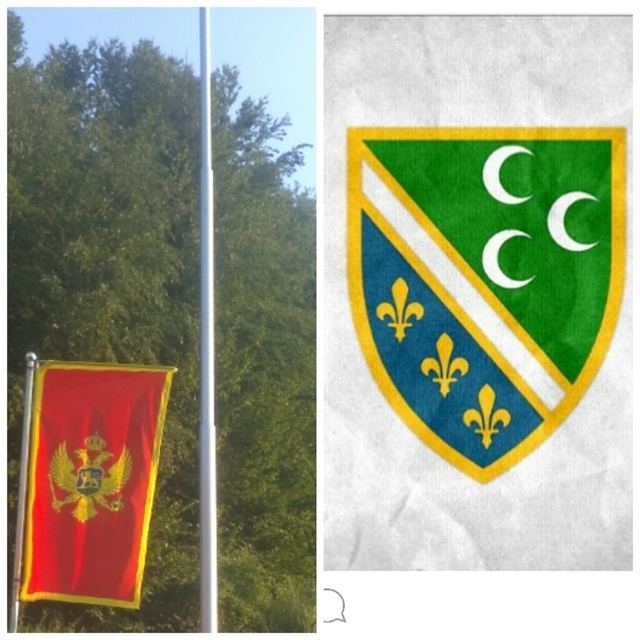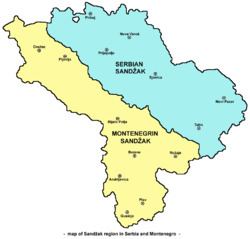 | ||
Bosna na a domovina sand ak mila otad bina
Sandžak (Serbian Cyrillic: Санџак, [sǎndʒak]) or Sanjak is a historical geo-political region, now divided by the border between Serbia and Montenegro. Тhe name Sandžak derives from the Sanjak of Novi Pazar, a former Ottoman administrative district. Between 1878 and 1909 the region was placed under Austro-Hungarian occupation, following which it was ceded back to the Ottoman Empire. In 1912 the region was divided between the kingdoms of Montenegro and Serbia. Montenegrins and Serbs refer to the region by its medieval name Raška. The most populous city in the region is Novi Pazar in Serbia.
Contents
- Bosna na a domovina sand ak mila otad bina
- Etymology
- Geography
- History
- Demographics
- Serbian Sandak
- Montenegrin Sandak
- Sandak as a whole
- References

Etymology

Sandžak is the transcription of Turkish sancak (sanjak, "province"); the Sanjak of Novi Pazar, known in Serbo-Croatian as Novopazarski sandžak. In Serbian, the region is known by its pre-Ottoman name, Raška.
Geography
It stretches from the southeastern border of Bosnia and Herzegovina to the borders with Kosovo and Albania at an area of 8,403 square kilometers. Six municipalities of Sandžak are in Serbia (Novi Pazar, Sjenica, Tutin, Prijepolje, Nova Varoš, and Priboj), and five in Montenegro (Pljevlja, Bijelo Polje, Berane, Rožaje, and Plav). Sometimes the Montenegrin municipality of Andrijevica is also regarded as part of Sandžak.
The largest city in the region is Novi Pazar (66,527), while other large towns are: Pljevlja (19,489), and Priboj (14,920). In Serbia, the municipalities of Novi Pazar and Tutin are part of the Raška District, while the municipalities of Sjenica, Prijepolje, Nova Varoš, and Priboj, are part of the Zlatibor District.
History
The Serbian Despotate was conquered by the Ottoman Empire in 1455. During the Ottoman rule, many inhabitants converted to Islam. The conversions were caused by number of factors, mainly economic as Muslims paid lower taxes. The Muslims were also privileged compared to Christians, who were unable to work in the administration or testify in court against Muslims. The second factor that contributed to the Islamisation were migrations. A large demographic shift occurred as Serbs fought several wars against the Ottoman Empire. The Turks drove the Christian population northwards, while Muslims were driven to the Ottoman territory. The land abandoned by the Serbs was settled by Muslims, mainly ethnic Serbs who confessed Islam and Turks, but also significant population from the Caucasus, the Middle East and the Asia Minor. Large migrations occurred throughout the 18th and 19th century. The third factor of Islamisation was the geographical location of Sandžak, which allowed it to become a trade centre, facilitating conversions amongst merchants.
The second half of the 19th century was very important in terms of shaping the current ethnic and political situation in Sandžak. Austria-Hungary supported Sandžak's separation from the Ottoman Empire, or at least its autonomy within it. The reason was to prevent Serbia and Montenegro to unify, and allow Austria-Hungary's further expansion to the Balkans. Per these plans, Sandžak was seen as part of Bosnia and Herzegovina, while its Muslim population played a significant role giving Austrian-Hungarians a pretext of protecting the Muslim minority from the Christian Orthodox Serbs.
Administratively it was part of the Sanjak of Bosnia until 1790, when it become a separated Sanjak of Novi Pazar. However, in 1867, it become a part of the Bosnia Vilayet that consisted of seven sanjaks, including the Sanjak of Novi Pazar. This led to Sandžak Muslims identifying themselves with other Slavic Muslims in Bosnia.
In October 1912, Sandžak was recaptured by Serbian and Montenegrin troops in the First Balkan War, and its territory was divided between the Kingdoms of Serbia and Montenegro. Many Slavic Muslims and Albanian inhabitants of Sandžak emigrated to Turkey as muhajirs. There are numerous colonies of Sandžak Bosniaks in Turkey, in and around Edirne, Istanbul, Adapazarı, Bursa, and Samsun, among other places. During World War I, Sandžak was under occupation of Austria-Hungary from 1915–18. like between 1878 and 1908.
After the end of the World War I, Sandžak was included in the newly formed Kingdom of Serbs, Croats and Slovenes. It was a link between the Muslims in the West in Bosnia and Herzegovina and those in the East in Kosovo and Macedonia. Sandžak was the only region in Serbia populated by the Slavic Muslims. The Sandžak Muslims suffered from the loss of their economic status since the decline of the Ottoman Empire, and during the agrarian reform carried out in the Kingdom of Yugoslavia. This led to the Muslim emigrations to the Ottoman Empire.
The new communist regime in the Socialist Federal Republic of Yugoslavia found Sandžak with the Slavic Muslim minority of 43% and the Serb majority of 56%, along with smaller Albanian and Catholic minorities. During the World War II, until its abolition, Sandžak had an equal status to other federal units. The Muslims, who had generally anti-Partisan attitude, wanted unification of Sandžak with Bosnia and Herzegovina, or at least to be taken as a whole either by Serbia or Montenegro. However, Sandžak was later divided between Serbia and Montenegro, the outcome the Muslims wanted the least.
The Anti-Fascist Council of People's Liberation of Sandžak (AVNOS) had been founded on 20 November 1943 in Pljevlja. In January 1944, the Land Assembly of Montenegro and the Bay of Kotor cited Sandžak as part of a future Montenegrin federal unit. However, in March, the Communist Party opposed this, insisting that Sandžak's representatives at AVNOJ should decide on the matter. In February 1945, the Presidency of the AVNOJ made a decision to oppose the Sandžak's autonomy. The AVNOJ explained that the Sandžak hadn't a national basis for an autonomy and opposed crumbling of the Serbian and Montenegrin totality. On 29 March 1945 in Novi Pazar, the AVNOS accepted the decision of the AVNOJ and divided itself between Serbia and Montenegro. Sandžak was divided based on the 1912 demarcation line.
Economically, Sandžak remained undeveloped. It had a small amount of crude and low-revenue industry. Freight was transported by trucks over poor roads. Schools for business students, which remained poor in general education, were opened for working-class youth. The Sandžak had no faculty, not even a department or any school of higher education.
Sandžak saw a process of industrialisation, during which factories were opened in several cities, including Novi Pazar, Prijepolje, Priboj, Ivangrad, while the coal mines were opened in the Prijepolje area. The urbanisation caused a major social and economic shift. Many people left villages for towns. The national composition of the urban centres was changed to the disadvantage of the Muslims, as most of those who inhabited the cities were Serbs. The Muslims continued to lose their economic status, continuing the trend inherited from the time of the collapse of the Ottoman Empire and the agrarian reform in the Kingdom of Yugoslavia. The emigration of the Muslims to Turkey also continued, caused by the general underdevelopment of the region, disagreement with the communist authorities and the mistrust with the Serbs and Montenegrins, but also due to the nationalisation and expropriation of property. Serbs from Sandžak also moved to the wealthier regions of the central Serbia or to Belgrade or Vojvodina, while the Muslims moved to Bosnia and Herzegovina as well.
With the democratic changes in Serbia in 2000, the ethnic Bosniaks were enabled to start participating in the political life in Serbia and Montenegro, including Rasim Ljajić, an ethnic Bosniak, who was a minister in the Government of Serbia and Montenegro, and Rifat Rastoder, who is the Deputy President of the Parliament of Montenegro. Census data shows a general emigration of all nationalities from this underdeveloped region.
Demographics
Sandžak is a very ethnically diverse region. Most Bosniaks declared themselves Muslims by nationality in 1991 census. By the 2002/2003 census, however, most of them declared themselves Bosniaks. There is still a significant minority that identify as Muslims by nationality to this day. There are still some Albanian villages (Boroštica, Doliće and Ugao) in the Pešter region. Though due to past sociopolitical discrimination of Albanians in the former Yugoslavia after World War Two, these Albanians have opted to refer to themselves in censuses as Bosniaks.
Serbian Sandžak
According to the 2011 census in Serbia, a total of 201,728 people live in the Serbian portion of Sandžak. Bosniaks, numbering 142,373 hold an overall majority (59.4%) in this part of region, mainly concentrated in the eastern part of Serbian Sandžak. Serbs, numbering 77,555 (i.e. 32.5%), make up the majority in most of the western part of Serbian Sandžak.
Montenegrin Sandžak
According to the 2011 census in Montenegro, the Montenegrin part numbers 151,950 people. The ethnic composition of the Montenegrin part is significantly more mixed than that of the Serbian part. No ethnic groups forms an absolute majority in the Montenegrin part.
Sandžak as a whole
A calculation of the two censuses puts Sandžak's total population at just over 390,000. The relative majority is held by the roughly 189,190 Bosniaks, who form 48.4% of the region's population. Serbs form 33.9% (132,345), while Montenegrins form 7.25% (28,323), Muslims by nationality 6.11% (23,900), and Albanians 1.04% (4,062).
